The Best Cars up for Grabs at the 2024 Arizona Auctions
This biggest month of collector car auctions is upon us. As Mecum’s extravaganza in Kissimmee winds down, we’re gearing up to look west to Arizona, January’s original main event.
As Kissimmee has consistently and dramatically grown over the years, Scottsdale—which is made up of several separate auctions going on during the same week—has been more nuanced. Barrett-Jackson (the original and anchor event in Arizona) has been a constant, other companies have come and gone, and some have skipped years and come back.
This year, talk of a cooling market is on market observers’ lips, and total sales are expected to drop in Scottsdale this year despite a similar number of vehicles on offer. Even so, there are always incredible cars on offer in Arizona each January, and below are the best ones in 2024.
2015 Ferrari LaFerrari
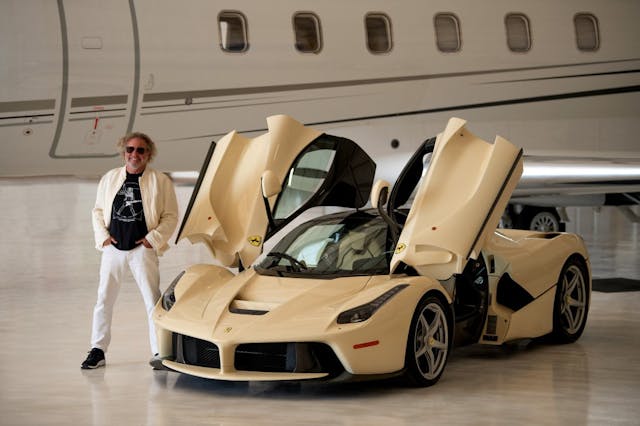
Van Halen singer Sammy Hagar ordered this LaFerrari new, and the Rock and Roll Hall of Famer will be the one selling it at Barrett-Jackson. The “Why Can’t This Be Love” vocalist may have belted out “Black and Blue,” but he ordered his Italian hybrid hypercar in unique cream over cream leather with carbon fiber and black accents, along with his initials on the steering wheel.
Hagar also lyrically complained “I Can’t Drive 55” in his famous black 512 BBi, but apparently he couldn’t drive his LaFerrari much at all. The car has racked up just 1100 miles. “Everyone asks why I am selling it. It’s so fast and so powerful, it’s beyond my skills and abilities,” he told Barrett-Jackson. Respect, Sammy. “It Feels So Good” to tell the truth, and at least you’re a “Good Enough” man to admit it. But even if you have “Dreams” of making this one-of-500 LaFerraris “Mine All Mine,” you’ll need “Big Fat Money” to be the one on “Top of the World” by the time bidding ends. Hagerty Price Guide values for this halo-model Ferrari range from $2.75M – $4.4M.
1965 Aston Martin DB Short-Chassis Volante

“Volante” means “steering wheel” in Italian, but in English it means “moving with light rapidity,” and if you don’t speak Aston Martin, it also means “convertible” in the vernacular of British luxury sports cars. The first use of the Volante name on an Aston was on an interim model in 1965-66, when the company phased out its hit DB5 for the more-refined DB6.
Aston still had extra DB5 chassis laying around after the DB6’s debut, though. Since they couldn’t just slap a DB6 body on top given the former’s shorter wheelbase, they instead built a run of 37 drop-tops that basically have the (more attractive) proportions of a DB5 with a few styling cues from the DB6. Aston fans call them “Short-Chassis Volantes.”
The one on offer in Scottsdale doesn’t have the cleanest resume (color change, converted from RHD to LHD, non-original gearbox), but with a car so rare it’s hard to be picky. Others have sold in Europe for €1,158,600 and €1,805,000. The pre-sale estimate for this one is $1,400,000 – $1,800,000.
1936 Bugatti Type 57 Atalante

Any Bugatti Type 57 is special, and the factory Atalante coupe bodywork is particularly gorgeous, but this example also led quite a life. One of four factory-built with a roll-top sunroof, it sold new to a jeweler who in 1938 used it to compete in the Rallye des Alps. His mistress served as navigator. The wife didn’t like fast cars, apparently. The car also did the Monte Carlo and Rome-Liege-Rome rallies, and was also owned by French aviator Léon Givon.
It received restoration work in the late 1940s with a new engine, metal roof and different windshield, and its next owner in 1950 took it with him to live in the Belgian Congo. Then, during the upheaval of the Congo Crisis in the 1960s, he used the Bugatti to escape with his family and whatever belongings would fit to Northern Rhodesia. Things have been quieter for this Atalante since. It was re-restored in the late 1970s, but really got the attention it deserved, including reconstruction of the correct sunroof, during a restoration in the late 1980s. It’s been an occasional show car since, and has a $1.5M-$1.8M pre-sale estimate for Scottsdale.
2020 McLaren Speedtail
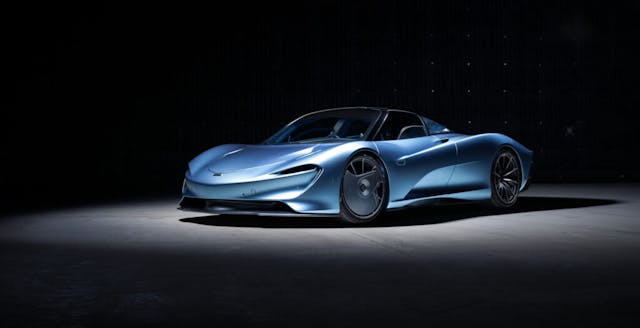
McLaren billed the 2020 Speedtail as a spiritual successor the company’s greatest hit, the F1. Like that ’90s icon, the Speedtail has cutting edge tech and materials, a central seating position flanked by two passenger seats, and an ultra-exclusive 106-unit production run.
This car is the 69th one built. Finished in Liquid Blue Silver over blue and gray, it’s still essentially new with just 54 miles. Speedtails are worth nowhere near as much as their eight-figure F1 ancestors, but they are still expensive. While a handful have sold for over $3M at auction, the mid-$2M has been more common lately, and this one has a $2.0-$2.5M estimate.
1937 Mercedes-Benz 540K Special Roadster by Mayfair
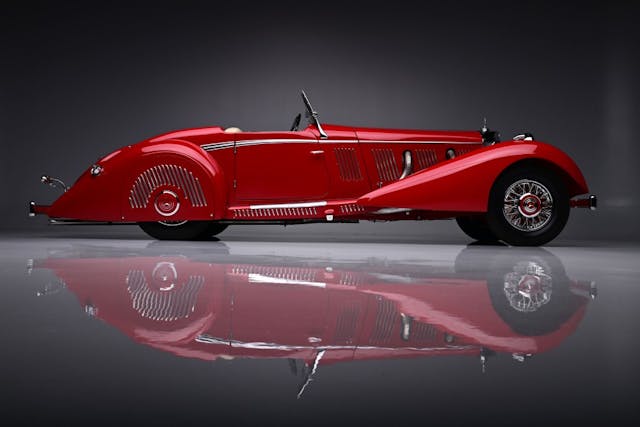
Like with the Bugatti Type 57, any Mercedes-Benz 540K is special, even more so when it’s a Special Roadster. This one piques our interest, though, since it isn’t one of the factory-bodied “Sindelfingen” Special Roadsters but a one-off job by London coachbuilder Mayfair, who somehow gave the Benz even more swoops and flourishes. The bright hood louvers, fender skirts and frame covers along with the outside exhaust headpipes, and Mother of Pearl instrument panel all make for a spectacular automobile.
We’ve seen the car before, as it sold for $2,530,000 in Monterey in 2007, and there again for $3,277,500 in 2018. It went back to Monterey last year and was a $2.6M no-sale. It’s a no-reserve auction this year at Barrett-Jackson, so it will find a new home.
1968 Ferrari 330 GTS
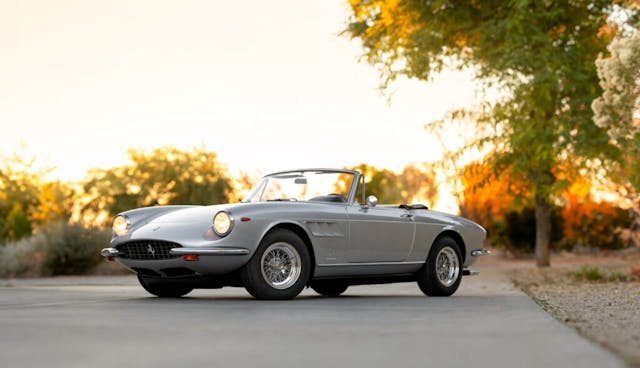
Basically an open-top version of the 330 GTC, the Ferrari 330 GTS was the successor to the 275 GTS, and is both a prettier and a faster car. It is also exceedingly rare. Ferrari sold just 100 of the Pininfarina-bodied drop-tops, and the one in Scottsdale is represented as the 86th.
You know what they say, when the top goes down the price goes up. In this case, way up. A regular hardtop 330 GTC has a condition #2 (Excellent) value of $575K in the Hagerty Price Guide, but for a 330 GTS it’s $2.4M, and this one has a pre-sale estimate of $1.75M-$2.25M.
1931 Duesenberg Model J Convertible Sedan by Franay
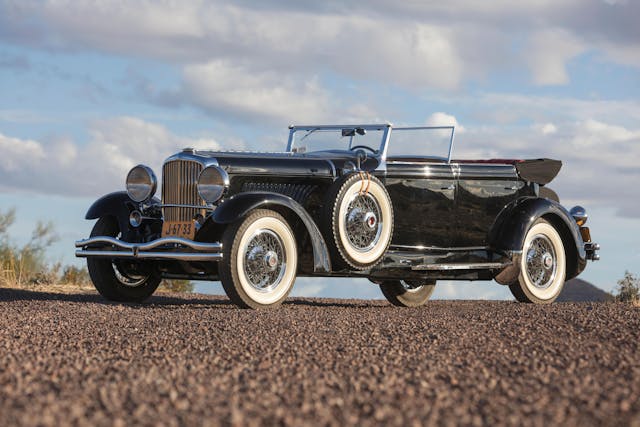
The Duesenberg Model J is a triumph of American design and engineering, offering world-class luxury and astounding performance for the bigwigs with deep enough pockets to buy one. No surprise, then, that it also appealed to the panjandrums on the other side of the Atlantic. If the Model J was fit for Hollywood, it was also fit for royalty. Literally, in this car’s case.
After being clothed in this dual-windscreen convertible sedan body by coachbuilder Franay of Paris, it was shown at the 1931 Paris Salon and sold to Queen Maria of Yugoslavia. She reportedly liked it a lot, writing of the “absolute security” at high speed as well as its “grand comfort, remarkable suppleness, and supreme elegance.” By the 1940s, the car had returned to the United States and, after its restoration in the mid-1990s, has been a show car. For Scottsdale, its pre-sale estimate is $2M-$3M.
1963 Shelby Cobra

RM Sotheby’s bills this as “likely the most obsessively documented Cobra on the planet.” That’s reassuring, especially since it is also represented as the first Cobra with a 289 engine, and one with just three owners from new. Ordered new by a computer scientist at Stanford, CSX2044 was originally slated to get the 260, the engine used on the earliest Shelby Cobras. But the owner had inquired about Ford’s new 289 and his numerous changes to the order apparently delayed things to the point that when it came time to plop in an engine, he got the newer, larger one.
Options included a roll bar, seat belts with shoulder harnesses and impact reels, dual mirrors, sun visors, wind wings, heater, chromed air cleaner and aluminum rocker covers for a total cost of $7,297.33. The buyer also fitted larger taillights from a Ford truck and reflective red tape to the rear to make his little roadster more safely stand out on the road at night. After covering 23,000 miles, a muffler knocked loose and the California scientist stowed it away in the garage, too busy working on the early Macintosh computers. It has since left the garage but, other than a repaint and upgraded carburetor, is reportedly just as it left Shelby American in 1963.
While not the first Cobra ever (that car sold for $13.75M in 2016), being the first 289 has to count for something, and since so many genuine Cobras have long since been restored, there’s something special about an original one. CSX2044 has a $1.2M-$1.4M estimate in Arizona.
***
Check out the Hagerty Media homepage so you don’t miss a single story, or better yet, bookmark it. To get our best stories delivered right to your inbox, subscribe to our newsletters.
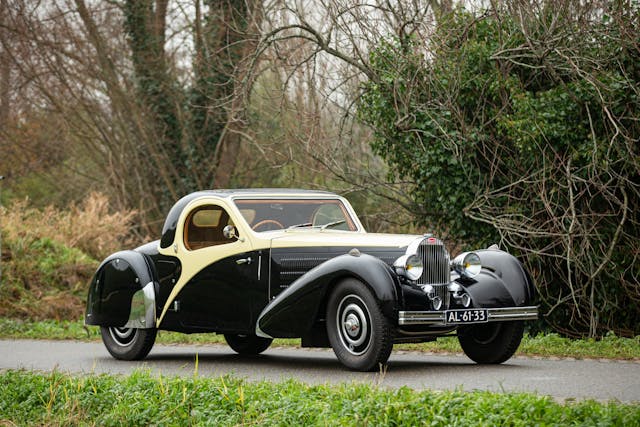


All I know is that in 1965, Emilio Largo’s high-performance yacht was named the “Disco Volante”, or the “Flying Saucer”. If it was good enough for the movie “Thunderball” and James Bond, it’s good enough for me. I’m not buying the “steering wheel” translation.
The Bugatti, the Mercedes, and the Duesenberg will have to fight it out for the pinnacle of motordom. The only thing that tops them all is the Delahaye from yesterday’s article.
A friend who owned at various times a Type 57 and Type 101 Bugatti said his Delahayes (he owned several) were better cars. I’d revise that pinnacle, Monsignor Hart. If not to the degree as Enzo Ferrari, Ettore Bugatti offered street cars to subsidize racing. Honest Bugattists will admit to porous castings and other maladies you don’t see in cars built in big factories with more engineering support. Certainly, like street Ferraris since, Bugattis “lighten up” at speed, but many, including writer Ralph Stein, who well knew most of the fine marques, preferred Alfa Romeo.
Ettore Bugatti drove a Packard Eight on long, fast business trips.
Never forget that it took n i n e (9) years and several iterations to dispatch 480 Duesenbergs, mainly to Hollywooders and the scions of industrial wealth not put out by the Depression, obsolete two years after their introduction, steel con rods introduced for the few dozen blown ’32s quickly retrofitted in many Js. Their long timing chains could stretch at high rpm upsetting valve timing. You’ll find the very few driving Duesenbergs have done considerable revisions, and no way do dohc and a cuckoo box of gears telling you it’s time to change oil, check battery water, or that the Bijur chassis lubrication used in dozens of other premium automobiles was in operation make a Duesenberg five to six times better than an arguably better looking 1931-33 Chrysler Imperial.
An old friend’s on his third Model J. Top-line farm tractors offered polished aluminum, enameled engines and accessories during the Depression to attract what money remained. Nothing new there. Fred Duesenberg wanted to build something the size of his earlier Model A and X, about that of the concurrent ohc Stutz, but E. L. Cord wanted a “super car,” not unlike today’s “hyper” cars du jour that depreciate faster than they accelerate. Nothing changes this reality, regardless how many pizza magnates, casino owners, and TV comics own them.
Duesenberg advertised an arbitrary 265 hp because E. L. Cord wanted to purvey the most powerful passenger car in the world, and an existing limited-production Mercedes boasted 250 hp, itself inflated.
I for one enjoy seeing theses amazing works of automotive art. Even though the money is out of the question the high end market is cool to see. The more “moderate” priced american entrys in the auction world are represented in great quantity on sites such as Mecum at Kissammee earlier this month for prices ranging from the teens to seven figures. Though I am an import guy I do like them all !
To very nice Sunbeam Tigers will also be up, including the first Tiger on the Jensen assembly line.
I’ll buy the 37 Mercedes if they drop the price $200,000
None! I am a hot rod guy!
I suggest your writing staff consult a dictionary, look up the word ORIGINAL. The 289 cobra has had a repaint, that suggests, by definition, it is not ORIGINAL. Haggerty should know better, you should all be ashamed of yourselves for this UNDERSIGHT!
“All Things Considered”, the Cobra fir me.
Most cars are interesting – common models that those of limited means can actually afford, beautifully-restored models from our youth, restomods of our favorite old cars, and poster cars that we had on our bedroom walls as young dreamers (usually foreign models).
You whiners complaining about this content could be more selective in which articles you read. I would’ve skipped right over this one if the cover photo wasn’t of a Cobra. But when Kyle Smith and Josh Arakes publish in the same issue my brain locks up for a moment deciding which to read first!
I just saw a 63 Cobra freshly restored at the 23 fall Hershey AACA show. Restoration guy said it had just been appraised at $1.2 million and owner figured that figure would go up if trophy was awarded. So that quote doesn’t seem like 1st 289 pushed price up much. Maybe it was the truck taillights and the reflective tape.
No contest, the Cobra would be my pick. Everybody thinks the 427 cars are awesome, and they are. I’ve always preferred the trim and balanced look of the 289 cars. (They handle better too…) Got to drive one rather sedately for a half hour or so in the early 80s. Switched seats with the owner after that and he showed me a little of the way it was designed to be driven. What a car.